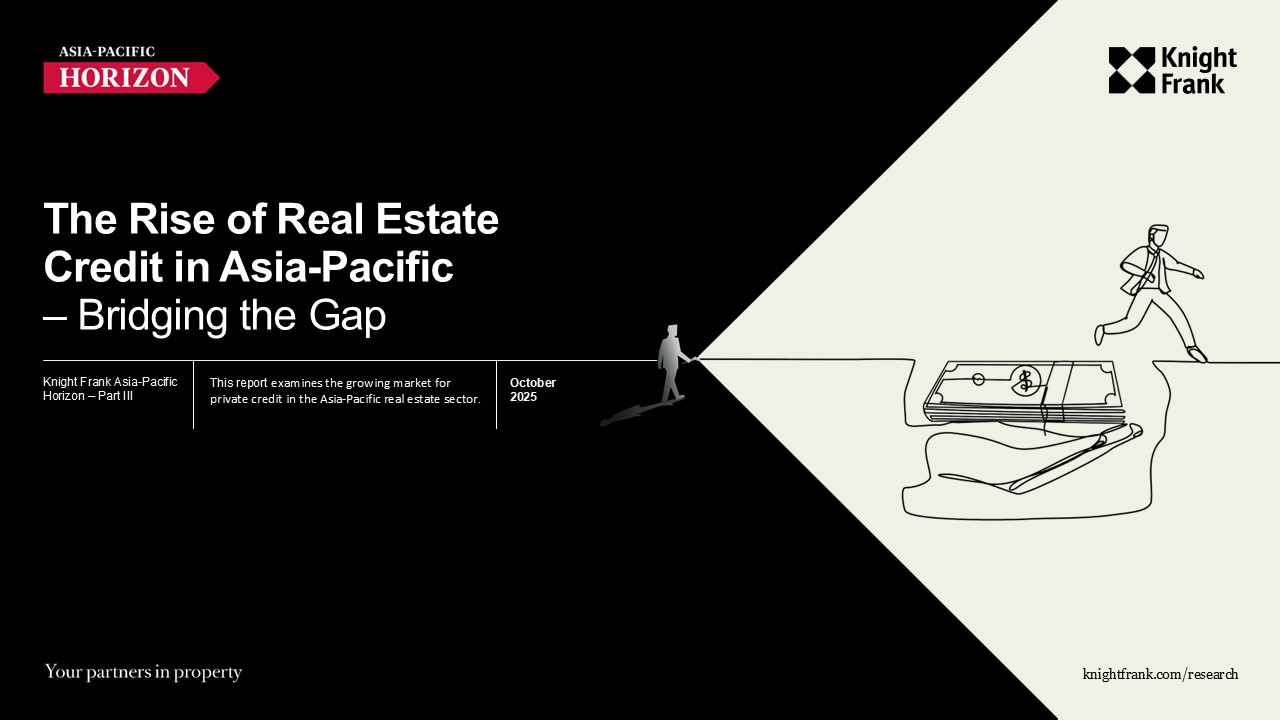
Asia-Pacific real estate private credit raised US$11.2 billion between 2020 and 2024, marking a 40% increase that signals the region’s growing prominence in alternative lending, according to Knight Frank’s Horizon Part III: The Rise of Real Estate Credit in Asia-Pacific — Bridging the Gap report.
Australia leads regional activity, capturing 40% of the US$11.2 billion raised between 2020 and 2024. Private credit now accounts for an estimated US$50 billion or 16% of total commercial real estate lending in the country, as conservative bank policies push more borrowers toward specialist private credit funds.
India follows with 36% of regional fundraising, followed by South Korea (11%) and Japan (5%), with the remaining 8% spread across other markets.
The Knight Frank report projects there will be US$90 to US$110 billion in private credit growth over the next three years across Australia, Hong Kong SAR, India and South Korea.
Australia is expected to drive almost 50% of this expansion, with India contributing 20-25%, based on anticipated real estate debt growth and private credit’s expanding market share through 2028.
While the APAC region currently represents 5% of global private credit fundraising, institutional investors and family offices increasingly recognise Asia-Pacific’s attractive risk-adjusted returns and diverse opportunity set, creating significant expansion potential.
Despite its under-representation, the region shows clear momentum. Average fund sizes in Asia-Pacific have consistently exceeded US$100 million since 2022, reflecting stronger capital commitments and rising real estate project funding requirements.
Knight Frank Director, Capital Advisory, Global Capital Markets Simon Mathews said: “Private credit is becoming an increasingly prevalent financing option for developers and investors across Asia-Pacific, offering speed, flexibility, and solutions, in place of or complementing traditional lending sources. Our research shows that while banking relationships continue to anchor the market for core investments, non-bank lenders are increasing their market share for opportunistic business plans, in markets such as Australia, India, Hong Kong SAR and South Korea.”
Knight Frank Australia Partner, Head of Capital Markets Michael Kwok said: “Australia presents as one of the most attractive markets for global real estate private credit. While core investment properties remain very well banked at a lower leverage, a significant opportunity exists for private credit lenders to step in where traditional financing is less competitive, particularly in development, value-add projects, and higher-leverage solutions, most notably in the living and commercial sectors. For investors, this creates access to scalable opportunities targeting net returns of 9-12%, supported by a transparent legal framework and a stable market environment.”
Knight Frank Chief Economist Ben Burston said: “Australia’s private credit market has expanded significantly over the past decade, driven by both global capital shifts and structural changes in the local lending market. Globally, institutional investors have rotated into private credit to capture strong risk-adjusted returns and diversify their traditional equity investment strategies. Locally, the major Australian banks have pared back their exposure to commercial real estate in response to the implementation of Basel III, which altered the risk weights applying to different forms of lending.
“Looking ahead, private credit strategies will continue to be a key part of the investment landscape. Falling interest rates and stabilising asset values are expected to support a rebound in transaction activity, generating more opportunities for credit funds to work with developers and investors and reducing the risk of loan impairments as the market shifts to a recovery phase.
“In addition, easing construction cost inflation should enable higher levels of apartment construction across all major cities in both traditional build-to-sell and build-to-rent formats, while easing funding conditions should strengthen origination pipelines.
“Over the longer term, the Australian market continues to offer the potential for significant growth. With the market penetration of private credit within total CRE lending at substantially higher levels in the US, the Australian market is not yet fully mature, and the share is likely to rise further. As this occurs, greater market depth will enable providers to offer larger and more sophisticated loans and achieve greater diversification across sectors.”
APAC market outlook remains positive despite risks
While acknowledging risks including regulatory evolution, liquidity constraints, and concentration exposure, the research suggests private credit will continue expanding its market share across Asia-Pacific. However, growth patterns will differ from Western markets due to the region’s relationship-driven banking culture and strong deposit bases.
The report positions Asia-Pacific’s private credit market as entering a maturation phase. Opportunities are expected to be selective and driven by cyclical dislocations, market stress, or borrowers’ needs for flexible capital solutions.
Simon adds, “With global interest rates remaining higher for longer, the case for private credit has strengthened, as debt funds continue to deliver attractive risk-adjusted returns. The last time interest rates were comparable was before the global financial crisis, positioning real estate credit to offer some of the most attractive risk-adjusted returns in over a decade.”






